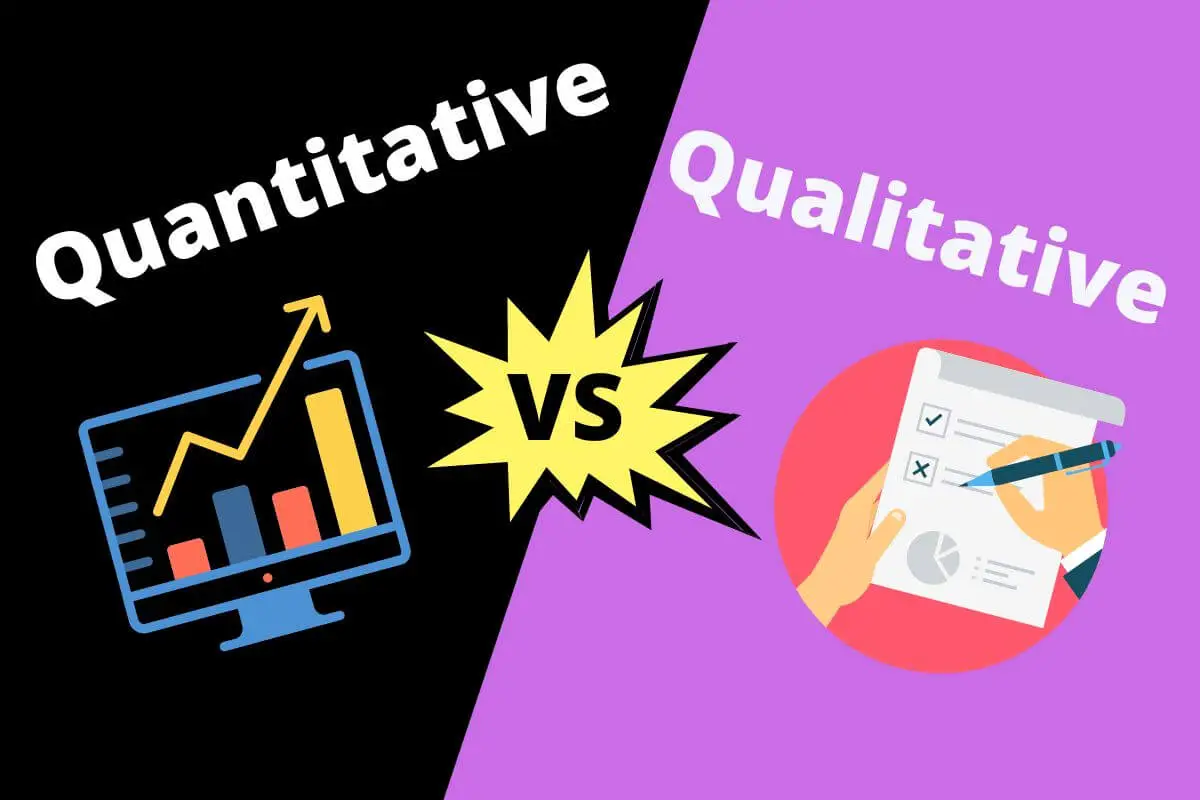When you can measure, count, or give a numerical value to your research, it’s quantitative data. But when you use language or words to express your research, it’s qualitative. In short, you present qualitative research through non-numerical data.
Data collection and analysis is one of the most crucial steps in research. There are two ways of data collection: quantitative and qualitative, and both of these vary from each other based on different parameters.
Table of Contents
Quantitative vs Qualitative
| Quantitative | vs | Qualitative |
| It’s statistical research that answers how much, how many, and how often related questions | Definition | It’s non-statistical research that answers why related questions |
| Number based | Research base | Interpretation-based, related to language |
| Universal and fixed | Research status | Open-ended, non-definite, and subjective |
| Surveys, databases, polls, charts, graphs, questionnaires, experiments | Research sources | Case studies, in-depth interviews, conversation analysis, historical research, cultural records, hermeneutic research, critical social theories, behavior observations, session recordings, personal observations, etc. |
| Counting and measuring | Research methods | Observations and interviewing |
| Quantitative analysis is done through statistical means | Research analysis | Analyzed through grouping data into different categories |
| It happens in controlled and stable settings where the research uses well-structured spreadsheets, tables, graphs, etc. | Features | It happens in natural settings where the research uses different data, including images, texts, interview answers, etc. |
| Quick and easy to collect and more precise results | Advantage | It is more in-depth and gives you better insights into the research question |
| Quantitative research gives limited information, which may lead to ignoring the broader subject matter | Disadvantage | Very time-consuming, and the results are not precise and appropriate. Sometimes you may not be able to come to a conclusion |
What is Quantitative Data and Quantitative Research?
Quantitative data means data that you can quantify. It’s statistical, more defined, and rigid. You can measure quantitative data using numbers or values or give a numerical value.
Answers Questions Like
- How much?
- How often?
- How many?
You can collect such data through books, surveys, experiments, tests, metrics, market reports, etc.
Also, you can divide quantitative data into sub-categories like continuous and discrete data.
Quantitative research is about collecting, analyzing, and interpreting quantitative data.
Quantitative Analysis Examples
- How many customers are clicking on your website?
- How many people are investing in a SaaS businesses every year?

What is Qualitative Data and Qualitative Research?
When you collect data using non-statistical methods, it’s qualitative data. We can’t measure or give a numerical value to qualitative data through charts or graphs.
Qualitative data is semi-structured and requires labels, attributes, and other identifiers to categorize it.
And while collecting such data, we discuss a specific subject’s characteristics.
Answers Questions Like
- Why?
- How?
Qualitative Analysis Examples
- What’s it like growing up in a rural area?
- Why do lots of people have dark-colored hair?
- How do adults build friendships?
Qualitative research leaves open-ended questions where researchers study trends and meanings of specific actions or similar stuff. New researchers further examine the results or questions.
Qualitative research is also used for interpretation, developing hypotheses, theorizations, etc. It is more flexible compared to the rigid structure of quantitative analysis.

Qualitative vs Quantitative Research: Key Differences
The definition has made it quite clear about the type and purpose of quantitative and qualitative research.
Nature of Research
Qualitative research methods are non-numerical, while quantitative methods are numerical. We can measure quantitative research results, which we can’t do for the former.
Research Methodology
The research methodology of these two is also very different. Qualitative studies are undertaken on subjective characteristics of the focus groups and case studies where you interview certain representatives of a particular group about a specific issue. Such a type of analysis is more time-consuming because it requires data collection from numerous sources.
Quantitative data collection methods focus on more useful and definite sources.
Data Collection Sources
Because qualitative approaches are non-statistical, researchers collect data through documents, focus groups, interviewing people, cultural records, case studies, personal observations, etc.
In contrast, quantitative research methods collect data using questionnaires, surveys, database reports, experiments, etc.
Outcomes
The results of qualitative outcomes are derived from the testimonies of their informants. The conclusion is drawn by gathering, comparing, and evaluating the data or the input researchers have received.
Qualitative research tends to answer the why behind the research questions. Most often, there isn’t a clear outcome or result of the study, leaving an open-ended question.
But quantitative research results are derived from different numerical or statistical analyses. Quantitative approaches lead to a concrete development where we get to know the cause and effect of certain relationships.
Quantitative research answers the how or what of the original hypotheses and will either support or negate the initial results.
While qualitative and quantitative studies are equally important in conducting research, you must know which one is suitable for your type of research to get precise results. Also, remember that both research designs have pros and cons, and the outcome may not always be satisfactory

